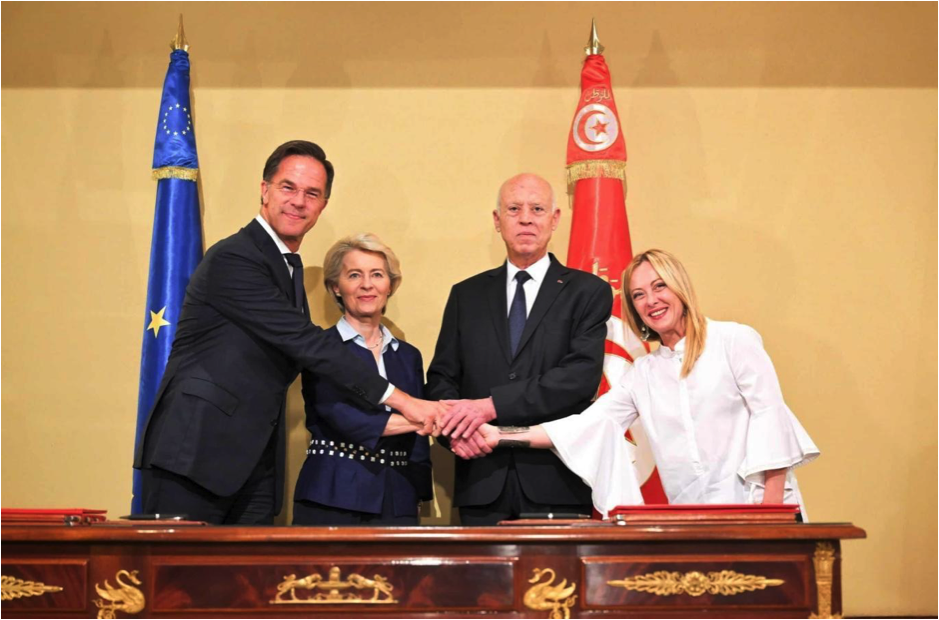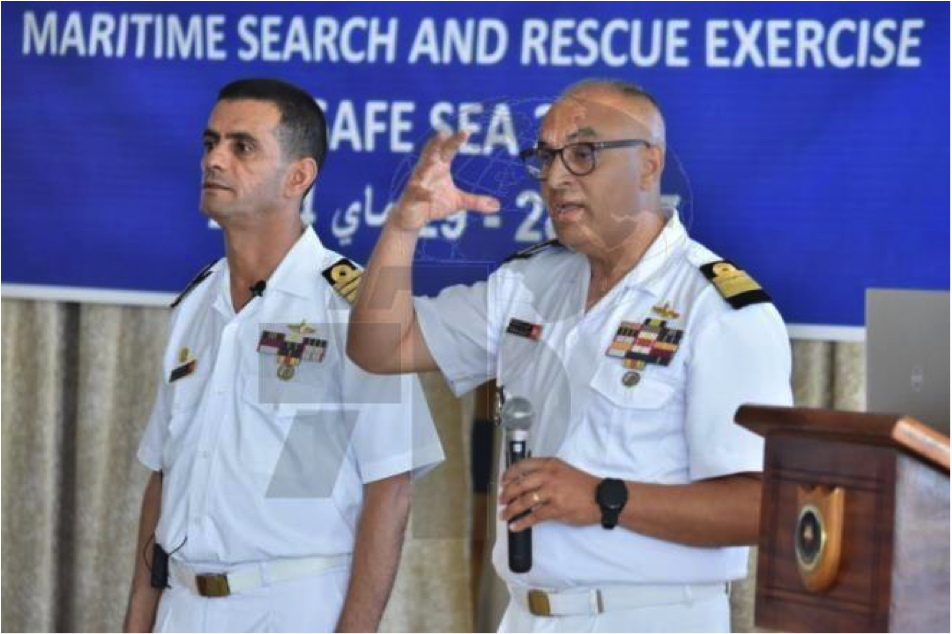Search and Rescue in the Central Mediterranean Sea: Tunisia Between the Hammer and the Anvil
Tunisian coast guard members stand next to the dead bodies of migrants in the port of Sfax, Tunisia, Dec. 24, 2020 Source: www.rfi.fr/en/africa
by: Hanen Ben Othman, University of Sousse
The Central Mediterranean route connects Libya and Tunisia with Italy and Malta. It has long been the deadliest and most perilous path in the world. According to the International Organization for Migration’s (IOM)’s Missing Migrants Project, the number of migrant deaths and disappearances across the Mediterranean surged from 2,048 in 2021 to 2,411 in 2022 reaching 3,041 by the end of 2023. The region has witnessed the highest number of casualties and missing people, with nearly 2,500 people losing their lives or going missing in 2023 alone while attempting to reach European shores. Between January and March 2023, the IOM documented 441 migrants and refugees deaths across on the Central Mediterranean route from North Africa to Europe though the actual number is likely higher due to unreported cases.
Once a space for cultural exchanges and a cradle of civilizations, the Mediterranean Sea has tragically become a route of death.
Given this dire situation, a pressing question arises: What is driving the increase in deaths along the Central Mediterranean route?
These tragedies can be partly attributed to the European migration and asylum policies, which transformed Europe into a fortress. Safe and legal migration routes are increasingly scarce, and those involved in search and rescue operations in the Central Mediterranean face harsh criticism. The European Parliament has strongly condemned delays in state-led rescue efforts, and at times, the complete absence of rescue missions, highlighting the lack of active and coordinated search and rescue operations at sea. This situation has placed significant pressure on Tunisia from the European Union and its member states, particularly Italy, leading Tunisia to establish its own search and rescue region.
EuroNEWS From left: Mark Rutte, Ursula von der Leyen, Kais Saied and Giorgia Meloni at the signing of the EU-Tunisia Memorandum of Understanding, July 17, 2023. Source: www.euronews.com/my-europe
The New Tunisian National Search and Rescue System: the Hand of the European Union?
Despite being a signatory to the International Convention on Maritime Search and Rescue (SAR Convention) since 1998, Tunisia hadn't formalized its own maritime search and rescue region, here after (SRR) until June 2024. This delay reflects the pressure exerted on Tunisia, resulting in reforms in this area. The Memorandum of Understanding on a Strategic and Global Partnership between the European Union and Tunisia, signed on July 16, 2023, exemplifies this pressure even though it is a soft law. Both parties share the priorities of combating irregular migration and agree to enhance the coordination of search and rescue operations at sea as well as implement effective measures to combat migrant smuggling and human trafficking, which includes Tunisia’s establishment of its SRR.
According to the International Convention on Maritime Search and Rescue, an SRR is a designated area where search and rescue services are provided This region should not be confused with a country’s territorial waters, over which it has sovereign authority, or its exclusive economic zone, where a coastal state has economic rights and can exploit natural resources. The SRR is also distinct from the contiguous zone, where the coastal state is only competent to prevent and punish infringements of its laws and regulations concerning customs, taxation immigration and health within its territory or territorial waters.
In response to this pressure, the Tunisian President issued Decree No.°2024-181 of April 5, 2024, organizing maritime search and rescue, which marks the first step toward establishing the SRR. The launch of the first maritime exercise conducted by the Tunisian Navy in late May was part of the implementation of this presidential decree.
Today, Tunisian’s SRR is officially established and its boundaries communicatedto the International Maritime Organization of the United Nations. But to date, there is no trace of its geographical markers neither in the Decree establishing it nor in the declarations of Tunisian officials.
The National Defense Ministry announced on Monday, from the main headquarters of the naval base at La Goulette, the launch of the first edition of Safe Sea 24" maritime search and rescue exercise in the Gulf of Tunis. Source: www.tap.info.tn
Controversy Surrounding the Establishment of a National System of Search and Rescue
While the establishment of the Tunisian System is a significant step in controlling irregular migration flows and saving lives, it has sparked controversy both within Tunisia and internationally. Tunisia found itself in a precarious position, facing heavy criticism for various reasons. Migrants and refugees intercepted or rescued at sea will be brought to Tunisian soil, in accordance with the provisions of the SAR Hamburg Convention. Some fear this could lead to an increase in the number of illegal migrants. At the same time, doubts persist about Tunisia’s capacity to manage rescued or detained migrants despite the EU’s financial support for equipment, training, and technical assistance as outlined in the Memorandum of Understanding. Some experts and legal professionals warn that the establishment of the SRR could impose constraints on Tunisia. They consider that the European Union has transformed Tunisia into a migrant trap serving primarily European interests.
Furthermore, the establishment of the SAR places Tunisia at the center of debates regarding the concept of a “place of safety”. Critics wonder whether Tunisia qualifies as a safe location for the disembarkation of rescued or intercepted persons along the Central Mediterranean route with some considering that it is not a safe country for either citizens or nationals. Ironically, this debate is occurring in Italy, where Tunisia is classified as a safe country.
According to the 2004 Resolution of the Maritime Safety Committee, a place of safety is defined as a “location where rescue operations are considered to terminate”. It is also a place where the survivors’ safety of life is no longer threatened and where their basic human needs (such as food, shelter, and medical needs) can be met. Furthermore, it is a “place from which transportation arrangements can be made for the survivors’ next or final destination”.
The obligation of the SAR state ends when the rescued people are disembarked in a place of safety. Unfortunately, this can be difficult to achieve, as evidenced by the Aquarius and the Ocean Viking cases. This situation reveals the impotence of international law relating to such a delicate thematic.
According to the 2004 Resolution of the Maritime Safety Committee, a place of safety is defined as a “location where rescue operations are considered to terminate”. It is also a place where the survivors’ safety of life is no longer threatened and where their basic human needs (such as food, shelter, and medical needs) can be met. Furthermore, it is a “place from which transportation arrangements can be made for the survivors’ next or final destination”. The obligation of the SAR state ends when the rescued people are disembarked in a place of safety. Unfortunately, this can be difficult to achieve, as evidenced by the Aquarius and the Ocean Viking cases. This situation reveals the impotence of international law relating to such a delicate thematic.
In Tunisia, the decision to formalize its SRR comes at a time marked by a migration crisis, violence, massive expulsions of Sub-Saharans, and uproar as the number of migrants reaches an unprecedented level, casting doubt on Tunisia’s qualification as a safe place for persons rescued at sea.
Contact:


